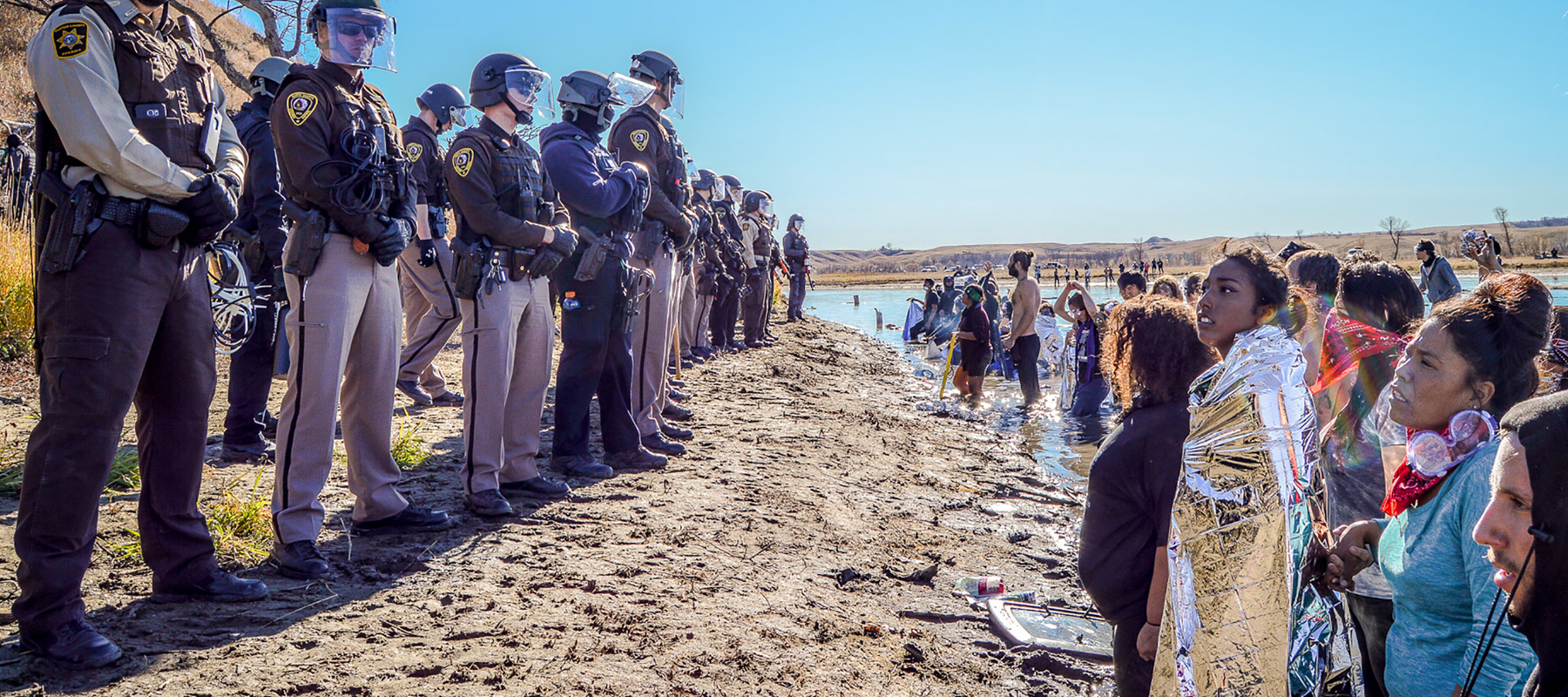
Standing Rock Spawned a Generation of Water Protectors. Now They’re on the Move.
Blocking pipelines from coast to coast
Above: Water protectors holding a ceremony on the banks of the Cannon Ball River were met by riot police who shot rubber bullets at point-blank range on Nov. 2, 2016. Photo by Robert Wilson.

August 9, 2017 | September Issue
Bismarck, N.D.—Forty miles north of where the Standing Rock resistance camps once stood, Matt Lone Bear and Carter Gunderson crouch on the curb, changing the brakes on a Chevy Blazer. As they wrestle a worn rotor off the axle, they discuss their plans. They’ll stick around until their court dates later in June, then hit the road for a tour of the Standing Rock diaspora—camps that have sprung up across the country to oppose fossil fuel projects, living on after the battle against the Dakota Access Pipeline (DAPL).
To the east, in Huntingdon County, Penn., the Gerhart family and their supporters have formed Camp White Pine on family property, which lies in the path of the Mariner East 2 natural gas pipeline. The pipeline’s owner, Energy Transfer Partners—the same company behind DAPL—hasinvoked eminent domain to cross the property, but construction faces resistance in the form of tree sits and other direct actions. Farther east, in Mahwah, N.J., the Native-led Split Rock Sweetwater Prayer Camp stands in the way of the Pilgrim pipeline. The camp’s Facebook page declares “solidarity with Standing Rock & all who resist the black snake worldwide.”
Lone Bear and Gunderson, however, think the next flashpoint is in Tacoma, Wash., where the Puyallup tribe and environmental groups are resisting a liquified natural gas plant.
“Tacoma seems like it’s got the confluence of all these trends in American resistance,” says Gunderson: There are water protectors in the spirit of Standing Rock, there’s a population center to draw on for mass actions, and it’s in the Northwest, where an anarchist-tinged direct-action culture thrives.
Lone Bear and Gunderson make unlikely friends. Gunderson, 26 and white, grew up in the wealthy Minneapolis suburb of Edina—“Audi Arabia,” he calls it. Lone Bear, 30, a father of four and a member of the Hidatsa tribe, grew up on the Fort Berthold Reservation, north of Bismarck. Their paths might never have crossed had they not been locked in the same jail cell Oct. 22, 2016, after police surrounded a prayer march south of the DAPL construction area and arrested 126 people. Held in an out-of-use rec room, they passed the time playing basketball with a sandal. And, says Gunderson, “We talked a lot. We basically talked about everything you could talk about.” Two days later they were arraigned on charges of criminal trespassing and engaging in a riot, and released on $250 bail.
Dozens of these cases have been dropped for lack of evidence. When Gunderson returned to North Dakota for his June 22 trial, he refused a pretrial deal—and 12 hours before the trial, he learned the charges had been dropped.
Lone Bear went to trial June 29. He paraphrases the judge, who had heard the previous cases from the mass arrest: “Did you guys bring any new evidence? No? Well, we’re not going to go through all that again.” The judge found Lone Bear not guilty.
Sam Saylor of the Water Protector Legal Collective calls the prosecution’s strategy “financial warfare.” “They’re trying to extract as much pain” as possible, he says, “so they can get pleas.” The goal, he thinks, is to discourage future protest and recoup some of the money spent policing the resistance. The Morton County State Attorney’s Office did not respond to requests for comment.
Of the 750 or so people arrested for trying to stop the pipeline from crossing the Missouri river, more than 400 still face criminal charges, says Saylor. Still, the spirit of Standing Rock has spread throughout the country—and repressive policing and surveillance methods have followed. In May, The Intercept reported that local, state and federal police coordinated with a mercenary security group called TigerSwan—hired by the pipeline company to surveil, infiltrate and thwart the #NoDAPL movement. TigerSwan is currently monitoring the opposition to the Mariner East 2 pipeline in Pennsylvania.
A TigerSwan “Situation Report,” dated Oct. 3, 2016, reads: “Exploitation of ongoing native versus non-native rifts, and tribal rifts between peaceful and violent elements is critical in our effort to delegitimize the anti-DAPL movement.” A February 27 company report brags about their “proven method of defeating pipeline insurgencies.”
For Lone Bear, in light of the TigerSwan revelations, it’s all the more important to stand together. That’s why he’s heading to Tacoma. “A lot of Native people at Standing Rock were from Washington state. I feel like I need to return the favor.”
grew up in Montana and spent more than a month in the Standing Rock camps.
